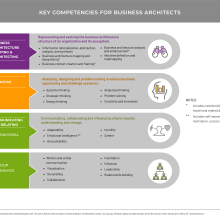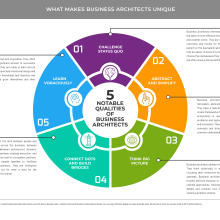This is our third and final installment of the Frequently Asked Business Architecture Questions (FABAQ) revival, which brings us to a total 50 FABAQs answered. Part 3 in our series explores FABAQs on the business architecture practice and role.
Why FABAQs? First, to help you understand. That is what StraightTalk is all about. But second, to help you help others by arming you with some straightforward answers to these questions – making you an even better leader, practitioner and advocate for the discipline. It’s sort of like having your own personal guide through the world of business architecture.
P.S. Make sure to check out Part 1 and Part 2 of our FABAQ series as well as the full set of FABAQs in their complete format. In some cases, the answers have abbreviated a bit here for the StraightTalk format. And, the full set provides valuable business architecture references that offer immersive information along with diagrams you can use.
Here we go one last time. Note: we’ve picked up the FABAQ numbering where we left off.
41. What is the Return on Investment for business architecture?
Many people are looking for Return on Business Architecture Investment (ROBAI) numbers they can use from other organizations to help build buy-in for business architecture within their own organizations. There’s good news and bad news. The bad news is that there is almost no business architecture ROI data in the public domain. That means the good news is that you’re not missing anything.
Therefore, it is most important to start creating your own business architecture ROI data (and consider sharing it with the global business architecture community). Knowing the ROI of your business architecture practice will give your business architecture team visibility to and accountability for value delivered to the organization. In addition, communicating the ROI of your business architecture practice will help you to build buy-in and advocacy for the discipline internally within your organization.
As a starting point, here is a method for determining your ROBAI. We can express ROI as a ratio or percentage.
ROBAI = (Business Architecture Benefits – Business Architecture Costs) / Business Architecture Costs
Business architecture costs are the summation of what your organization spends to create, maintain, use and govern its business architecture and supporting practice. For example, this could include team compensation, team training and resources, and tools.
Business architecture benefits are the summation of the metrics you have chosen that best monetize your value proposition. For example, this could include strategic value contribution, strategy execution performance improvement. operational performance improvement and business effectiveness improvement.
42. What is the best way to socialize business architecture within an organization?
There are 5 tenets of business architecture socialization that will help to guide you:
- Demonstrate business value – Don’t "sell" business architecture.
- Build the case for business architecture.
- Position business architecture within a strategy execution context.
- Make your business architecture communications compelling.
- Have patience with the journey.
Also keep in mind your specific situation and organizational dynamics when deciding when to communicate with whom. Some business architecture teams build buy-in quickly and decide to share with executives at the C-level and wider audiences throughout the organizations relatively early in their journey. However, most teams socialize within a smaller sphere of the organization and then socialize more widely once they have proven successes to share and the ability to scale. Either way, executive business sponsorship and advocacy is absolutely key to long-term success.
43. How can the value of business architecture be demonstrated quickly to help obtain buy-in?
Once an organization has a minimum business architecture baseline* in place, it is possible to leverage it for quick wins where value can be delivered in a short time. A few examples are below.
Quick Wins That Take Hours or Days
- Assess the Impact of Anything – For example, a potential business model change, strategy, innovation idea, product, acquisition, policy change, etc.
- Frame a Problem or Opportunity – To help scope, analyze and solve a problem or opportunity within the fullest, relevant business context. For example, you may identify that a problematic capability should be fixed within the context of many value streams, even if the original problem was identified within just one.
Quick Wins That Take Weeks (or less depending on the scope and complexity)
- Analyze Anything for Decision-Making – For example, investments, risks, cost allocations, organization, partners, simplification, system applications, etc.
- Visualize Strategic Direction – To reflect the most important capabilities (and value streams) to enable the organization’s strategies. This provides a great comparison point to evaluate any planned or in-flight work (e.g. formal initiatives, continuous improvement activities, planned investments, etc.).
- Reflect a Capability-On-A-Page – To illustrate an aggregate view of its current state and health, future state, active initiatives, stakeholders impacted, etc. which can be used to communicate the total picture for decision-making, identification of gaps and overlaps, etc.
Quick Wins That Take Months
- Translate One Strategy – To identify business and technology impacts, design a target state architecture, and create a strategic roadmap for execution. While this is more involved, if you do just enough, just in time you can demonstrate value and business architecture’s true role in translating strategy into initiatives for execution.
* Note: Considering the global methods, best practices and reference models that are now available, a minimum business architecture baseline can be established within an organization in an accelerated manner.
44. What is "success" for a business architecture practice? Is there a maturity model?
There are a few hallmarks of an organization with a successful and mature business architecture practice including:
- Business architecture is fully embedded – it’s just the way the organization works
- Business architecture is fully integrated with related teams and processes across the entire strategy execution life cycle
- Business architects are highly skilled and become trusted advisors to business and technology executives and teams
- The organizational mindset shifts to reflect enterprise optimization and cross-business unit collaboration, systemic and big picture thinking, value and customer/stakeholder focus, business first (versus solution) focus, and investment in the right things (versus execution only focus)
These organizations leverage business architecture as:
- A shared enterprise business language and mental model
- An enterprise business lens for analyzing investments, risks, opportunities for simplification, etc.
- A key component and connector for end-to-end strategy execution
There is a maturity model which measures the progress of an organization’s business architecture practice across various categories, against an objective standard. It does not measure the maturity of the organization’s capabilities, but rather the key aspects of a business architecture function.
The Business Architecture Maturity Model® (BAMM®) is available from the Business Architecture Guild®. Like other maturity models, the BAMM® includes a set of categories and levels. The categories cover all topics related to business architecture, business architects and the practice itself. There are five levels of maturity in the BAMM®, and as a practice progresses towards level 5, it becomes more strategic, more embedded into the fabric of the organization, and provides more value.
45. What can we learn from business architecture teams who have been successful?
While much can be learned from successful business architecture teams, there are a couple key success factors that top the list:
1. Successful business architecture teams are business and value-oriented.
These teams focus on the business in business architecture and continual delivery of value by leveraging the business architecture. Though powerful, business architecture is just a means to an end. Having executive business sponsorship is another key success factor, but if not feasible immediately it can be earned by continually demonstrating value.
2. Successful business architecture teams create a cohesive business architecture practice.
Because business architecture is meant to be practiced as an enterprise discipline, these teams adhere to two immutable principles:
- There is one shared business architecture for an organization*
- Business architecture practitioners utilized a shared methodology
* Unless the organization is a conglomerate or equivalent level of structural difference.
46. How is business architecture governed?
Business architecture governance includes the structures and processes to manage and control the integrity and effectiveness of all business architecture activities, and the creation and evolution of business architecture content.
Business architecture governance is not an isolated, theoretical activity. It is about something much bigger: the organization itself. As a result, business architecture governance is actually a means to ensure a solid structure and design for an organization as well as its future evolution.
As a starting point, consider two categories of business architecture governance:
- Business Architecture Content focuses on the creation and evolution of business architecture content
- Business Architecture Activities (a.k.a. the practice) focuses on the outcomes and services provided by the business architecture team
Within each of these two categories, there are also different types of governance as described below, to compare action to intent from a variety of perspectives. Each type of business architecture governance can be introduced over time, aligned with the appropriate milestones.
Business Architecture Content Governance
- Knowledgebase governance is performed by both cross-functional business representatives and business architecture experts to ensure the baseline business architecture content is correct, complete and high quality.
- Target business architecture governance is performed by both cross-functional business representatives and leaders as well as business architecture experts to ensure that target business architectures are designed with integrity, and align with business direction and other target architectures. This is especially important for large initiatives such as transformations which evolve the structure of the organization.
Business Architecture Activities
- Practice direction governance is performed by architecture and/or business leaders to ensure that the business architecture team outcomes and results are delivering on the purpose, value proposition and measures of success defined in the charter.
- Business architecture service delivery governance is performed by business architecture experts to ensure that business architecture services (e.g., business impact assessment service or target state design service) are delivered with consistency and according to the outcomes, principles and best practices defined within the team’s business architecture methodology.
- Business architecture tools governance is performed by business architecture experts to ensure that the business architecture content contained within repository is high quality and consistent.
While there will be unique aspects of business architecture governance as described above, the overall enterprise architecture governance structures and processes should be considered and integrated with as well.
47. Who does business architecture, just business architects or others within an organization?
There is a specific (and often missing) role for business architects within an organization, especially as it pertains to informing business direction and helping to translate it into a coordinated set of actions. In addition, an organization's business architecture can and should be used by anyone in the organization as they perform their own roles. For example, consider a Risk Manager who heatmaps their organization's value streams and capability map to analyze and communicate areas of risk.
Generally speaking, most organizations have defined a pure business architect role (often with a set of increasingly senior roles) which integrates with other roles and disciplines. However, there are a range of approaches for how business architecture is being practiced or is envisioned to be practiced within organizations. These include one or more of the following:
- A pure business architect role that integrates with other disciplines (including integration with the other IT architect roles within enterprise architecture)
- Practitioners practice a blended role of experience design/human-centered design and business architecture
- Practitioners blend enterprise or solution architecture aspects with the business architect role (Note: Teams tend to be moving away from this approach as it often proves to be less successful for a variety of reasons, but nonetheless it does exist and works for some)
- All or a portion of the business architect role is democratized through the usage of business architecture by many people in different roles and for different scenarios across the organization
- Aspects of the creation and usage of business architecture are automated
These approaches, and others, will likely continue to play out in different ways and the reality is that as long as we honor and standardize around the principles of business architecture, organizations and individuals can truly do what works best for their situations. There does not need to be a one-size-fits-all approach because organizations, geographies and cultures need different things. Hybrid approaches are also likely to occur.
48. What are the characteristics and competencies of successful business architects?
It is useful to think of business architect competencies in three distinct categories:
- Business Architecture Mapping and Architecting competencies – Representing and evolving the business architecture structure of an organization and its ecosystem
- Cognitive competencies – Analyzing, designing and problem solving in various business opportunity and challenge scenarios
- Communication and Relating competencies (behavioral and group dynamics) – Communicating, collaborating and influencing others towards understanding and change.
The diagram below describes a key set of competencies for each category.
Business architects are unique and consistently so across the world. While there is of course great variation from any one individual to another, business architects share a common set of characteristics that make them valuable to organizations. A few of the characteristics that make business architects unique include:
- Challenging status quo
- Ability to abstract and simplify
- Thinking big picture
- Connecting dots and building bridges
- Learning voraciously
The diagram below further defines each characteristic.
49. How does one become a great business architect?
There are a few key aspects of a great business architect that get to the heart of what makes them different and successful. These include:
- Knowledge (what you know) – This includes business architecture knowledge, general business knowledge and technology knowledge
- Experience (what you’ve done) – A few of the top most valuable experiences to have include mapping business architecture, using business architecture for portfolio management and initiative planning, architecting a business transformation and interaction with teams across the strategy execution life cycle*
- Competencies (what you can do) – See FABAQ #48
- Characteristics (who you are) – See FABAQ #48
* Chart your own course based on what interests you and where you want to take your career. For example, some business architects like to have another emphasis such as strategy, experience design, organizational design, change management or technology.
Keep in mind that that an individual business architect does not need to embody every aspect. On the contrary, business architecture teams can and should aspire to be diverse, in terms of team member personalities, abilities, interests, levels of experience and focus areas.
In addition, here are some of the most important things you can learn to become a great business architect:
- Build foundational business architecture knowledge and start with BIZBOK® Guide-aligned training
- Learn how to structure and evolve business models and formulate strategies to win
- Learn how to think and design
- Get good at storytelling and visualizing complex concepts and data
- Pursue a complementary passion
Here are some of the most important things you can do to become a great business architect:
- Create a business architecture foundation for the entire scope of a large organization and extend it over time
- Architect a digital transformation
- Facilitate the usage of business architecture for portfolio management and investment decision-making
- Architect a new start-up organization or help one to scale
- Walk for a while in other pairs of shoes
50. What is the role of visualization and storytelling in business architecture?
What makes a business architect successful is not just what they do, but how they do it – and that includes visualization and storytelling.
Business architects have (or can develop) a talent and passion to simplify and visualize complex concepts and show connections. They understand and leverage the power of visual techniques to bring people together and incite action. They are storytellers and change agents for new ideas.
Business architects leverage visualization and storytelling techniques as a part of change initiatives. For example, visualizations and storytelling can be used to ground people on the current state and rally them towards a common aspirational state and strategic roadmap – all represented at a level of detail that is high enough for an executive to consume. These techniques can also be used to facilitate interactive collaboration sessions with executives and other teams (e.g., using graphic facilitation) or capture the output visually (e.g., graphic recording).
Business architects leverage visualization and storytelling techniques as part of socializing the business architecture practice. This may include anything from decks, videos or animations that articulate the case for business architecture to dashboards which reflect the results achieved. Key business architecture views may also be shared through posters or a variety of electronic media.
MORE GOOD STUFF
You’ll notice that this section is a little light during our FABAQ series – because you have loads of related resources available to you on Biz Arch Mastery.
Biz Arch Mastery: Your place to master the art and science of business architecture for robust organizations, ecosystems, and a better world. Rich content, tools and accelerators to help you learn and successfully practice and leverage business architecture. Check out the full set of FABAQ content.
The Business Architecture Quick Guide (Business Architecture Guild®): Available on Amazon and Barnes and Noble.
The BIZBOK® Guide (Business Architecture Guild®): Of course. (Guild membership required.)
Embrace the Near Win (TED Talk): An outstanding TED Talk by Sarah Lewis packed with life wisdom and very applicable to the business architecture journey. “Success motivates us, but a near win can propel us in an ongoing quest.” “Mastery is in the reaching, not the arriving. It's in constantly wanting to close that gap between where you are and where you want to be. Mastery is about sacrificing for your craft and not for the sake of crafting your career.”


